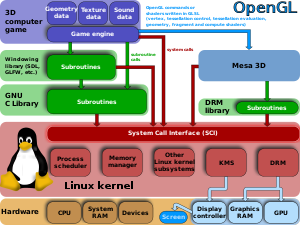| Original author(s) | Precision Insight, Tungsten Graphics |
|---|---|
| Developer(s) | freedesktop.org |
| Initial release | August 1998[1] |
| Stable release | 2.4.x
/ February 2009 |
| Written in | C |
| Platform | POSIX |
| Type | Framework / API |
| License | MIT and other licenses[2] |
| Website | dri |
| Original author(s) | Kristian Høgsberg et al. |
|---|---|
| Developer(s) | freedesktop.org |
| Initial release | September 4, 2008[3] |
| Stable release | 2.8
/ July 11, 2012[4] |
| Written in | C |
| Platform | POSIX |
| Type | Framework / API |
| License | MIT and other licenses[2] |
| Website | dri |
| Original author(s) | Keith Packard et al. |
|---|---|
| Developer(s) | freedesktop.org |
| Initial release | November 1, 2013[5] |
| Stable release | 1.0
/ November 1, 2013[5] |
| Written in | C |
| Platform | POSIX |
| Type | Framework / API |
| License | MIT and other licenses[2] |
| Website | dri |



The Direct Rendering Infrastructure (DRI) is the framework comprising the modern Linux graphics stack which allows unprivileged user-space programs to issue commands to graphics hardware without conflicting with other programs.[6] The main use of DRI is to provide hardware acceleration for the Mesa implementation of OpenGL. DRI has also been adapted to provide OpenGL acceleration on a framebuffer console without a display server running.[7]
DRI implementation is scattered through the X Server and its associated client libraries, Mesa 3D and the Direct Rendering Manager kernel subsystem.[6] All of its source code is free software.
- ^ Owen, Jens. "The DRI project history". DRI project wiki. Retrieved 16 April 2016.
- ^ a b c Mesa DRI License / Copyright Information - The Mesa 3D Graphics Library
- ^ Cite error: The named reference
dri2proto spec 2.0was invoked but never defined (see the help page). - ^ Cite error: The named reference
dri2proto 2.8was invoked but never defined (see the help page). - ^ a b Cite error: The named reference
dri3proto 1.0was invoked but never defined (see the help page). - ^ a b "Mesa 3D and Direct Rendering Infrastructure wiki". Retrieved 15 July 2014.
- ^ "DRI for Framebuffer Consoles". Retrieved January 4, 2019.